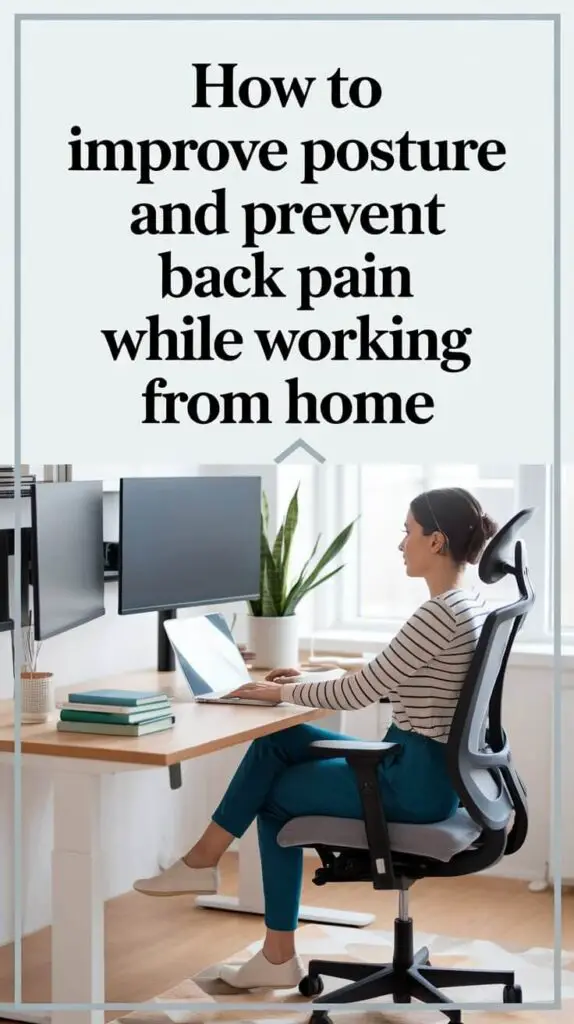If you are working from home and noticing back pain creeping into your day, you’re not alone. When I started working remotely, I didn’t think much about how my workspace setup could impact my body. After a few months, I found myself dealing with constant stiffness and discomfort in my back and shoulders. It turns out, poor posture and a lack of movement were the culprits.

In this article, I’ll share practical tips to improve your posture and prevent back pain while working from home, based on what worked for me and advice I’ve gathered from professionals.
Why Working from Home Can Affect Posture
Remote work often means setting up shop wherever it’s convenient—at the dining table, on the couch, or even in bed. These setups may not support proper posture, and over time, they can strain your back, neck, and shoulders.
Without the commute or office setup, you may also find yourself sitting for long hours without breaks. This can weaken core muscles and make it harder to maintain good posture.
Signs of Poor Posture
Before diving into solutions, it’s helpful to recognize signs of poor posture:
- Slouching or hunching over your desk
- Rounded shoulders or a forward head position
- Pain or stiffness in your back, neck, or shoulders
- Feeling fatigued even after sitting for a short time
For me, it was the constant ache in my lower back and tightness in my shoulders that made me realize I needed to change how I worked.
How to Improve Posture While Working from Home
1. Set Up an Ergonomic Workspace
Your workspace plays a big role in your posture. Ideally, your setup should support your body’s natural alignment.
- Chair: Use a chair with good lumbar support. If your chair doesn’t have built-in support, a small pillow or rolled-up towel can help.
- Desk: The desk height should allow your elbows to rest comfortably at a 90-degree angle.
- Screen: Position your monitor at eye level, so you’re not tilting your head up or down.
What Worked for Me: I invested in an ergonomic chair and raised my laptop using a stack of books until I could get a proper stand. These small changes made a noticeable difference.
2. Practice the 90-90-90 Rule
When sitting, aim for a 90-degree angle at your hips, knees, and elbows. Keep your feet flat on the floor and your back against the chair. This posture minimizes strain and keeps your spine in a neutral position.
3. Take Frequent Breaks
Sitting for long periods can cause your muscles to stiffen, making it harder to maintain good posture. Schedule short breaks every 30 to 60 minutes to stretch, walk around, or change positions.
Personal Tip: I set a timer on my phone to remind me to get up and move. Even a quick walk around the room helps reset my posture.
4. Incorporate Stretching and Strengthening Exercises
Strengthening your core and stretching tight muscles can support better posture. Some helpful exercises include:
- Cat-Cow Stretch: Gently stretches your spine and relieves tension.
- Child’s Pose: A relaxing stretch for your back and hips.
- Planks: Strengthens your core, which is essential for maintaining good posture.
What Helped Me: I started doing a quick 10-minute yoga session during my lunch break. It not only eased my back pain but also improved my focus.
5. Use a Standing Desk or Adjustable Workspace
Alternating between sitting and standing can reduce strain on your back. If a standing desk isn’t an option, consider using a sturdy countertop for part of your workday.
Personal Experience: I tried standing while working, and it gave my back some relief. Just make sure to stand with your knees slightly bent and shift your weight between your feet to avoid stiffness.
6. Be Mindful of Your Posture Throughout the Day
Even with a perfect setup, it’s easy to slip back into bad habits. Check in with yourself regularly to make sure you’re sitting upright with your shoulders relaxed and your chin slightly tucked.
Tips to Prevent Back Pain While Working from Home
1. Stay Active Outside of Work
Physical activity helps strengthen your muscles and improves flexibility, which supports better posture. Whether it’s a daily walk, yoga, or a workout routine, staying active is key.
2. Stretch Before and After Work
Starting and ending your workday with a few stretches can help counteract the effects of sitting for long hours.
3. Avoid Working from the Couch or Bed
While it’s tempting to work in these cozy spots, they don’t provide the support your back needs. Stick to a dedicated workspace whenever possible.
4. Keep Your Essentials Within Reach
Avoid straining your back by keeping frequently used items, like your phone or notebook, close by. This reduces the need to twist or overreach.
Long-Term Benefits of Good Posture
Improving your posture doesn’t just prevent back pain. It can also:
- Boost your energy levels
- Improve breathing and circulation
- Enhance focus and productivity
- Reduce the risk of long-term health issues like spinal misalignment
Conclusion
Working from home offers flexibility, but it can take a toll on your body if you’re not mindful of your posture. I learned this the hard way. By making simple adjustments to my workspace, incorporating movement into my day, and practicing good posture, I was able to reduce my back pain and feel more comfortable during work hours.
If you’re struggling with back pain while working from home, start small. Make a few changes to your setup, stay consistent, and listen to your body. Over time, these habits can make a big difference in how you feel.
